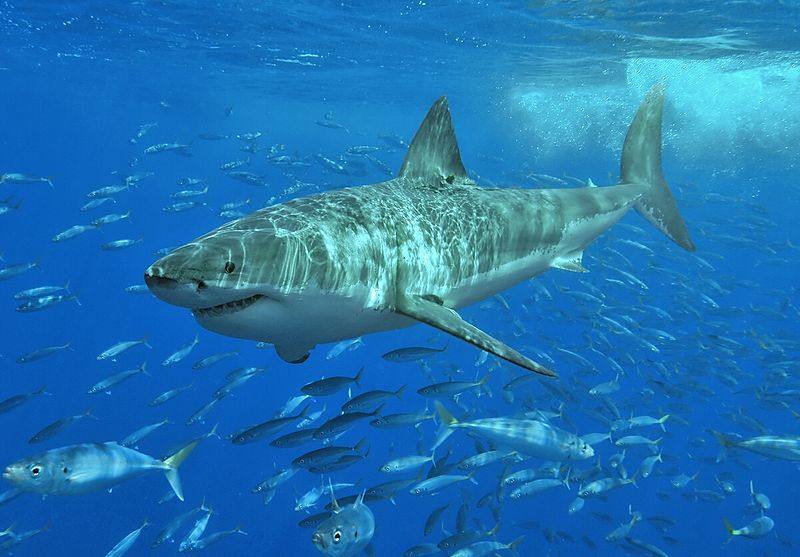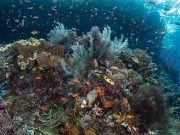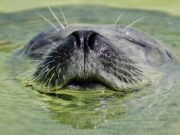Cage diving with sharks gives a chance to see these beautiful animals up close. However, it is controversial. There are concerns that cage diving will alter the sharks’ patterns of behaviour and lead them to associate humans with food. Indeed, New Zealand courts recently ruled that shark cage diving is an offence under the Wildlife Act. Scientific research on cage diving, though, concludes that the effect of cage diving is positive for the sharks, the environment and the local people – provided the dive operators conform to codes of behaviour.
1. Choose a responsible shark cage dive operator
The WWF, Project Aware and the Manta Trust have produced a Guide to shark and ray tourism, which includes guidelines for responsible shark cage diving.

Ask your chosen operator about their code of conduct before booking your diving.
2. Choosing the Right Exposure Suit
Cage diving involves being mostly still within a cage, for an extended amount of time. One of the most important considerations when going cage diving is therefore choosing the right exposure suit for the destination. The premier location for cage diving with great white sharks, Guadalupe, has water temperatures of 19 to 22 degrees Celsius during the shark season whereas other shark hotspots such as South Africa has cooler waters of 10 to 15 degrees Celsius. Divers should be sure to choose a thicker suit than usual to keep warm in the cage, and to get the most time in the water with the sharks.
3. Take Extra Clothing for Warmth and Quick Removal
Sharks can arrive and depart quickly from around the cage and divers need to be ready to get into the water at short notice. Wearing a good wind-proof jacket over their wetsuit and a woolly hat can keep divers warm whilst waiting for sharks to arrive. They can also be removed quickly to get into the cage. Keeping warm in-between dives is especially helpful at cooler shark destinations, to help ensure dive time isn’t cut short from being cold before even entering the water.
4. Take Motion Sickness Precautions for Surface Cage Dives
The ocean surface can be choppy at the best of times and the movement of a cage at the surface can be enough to trigger motion sickness for divers who don’t normally suffer from such sickness. If a diver is prone to motion sickness, it may be worth taking extra medication or precautions for surface cage dives. Alternatively, divers can consider a deep cage dive where there is less cage movement to deal with. Please be careful with taking motion sickness medication – none of the medications are free of side effects. If you do plan on taking medication give it a trial many days before diving in order to determine the response and side effects for you.
5. Consider Air Source and Dive Depth
There are two different cage options. Surface cages are commonly used. These are typically attached to the back of the boat with the top of the cage just at the surface. A second option is a submersible cage which are winched down with the divers into deeper water.
In surface cages divers use either air-supplied hookah through a hose or sometimes just snorkel. Deeper cages may use either the hookah or scuba.
6. Getting in and out of the Cage
This can be tricky. A good way is to make a seated entry using both your hands to lower yourself into the cage and the bars of the cage to climb down with your feet.
7. Photographing the Sharks
In a surface cage you can get great photos of the sharks using natural light. This gives more room when the cage is full of photographers. Submersible cages are generally larger so there is more room for strobes.
 Image: Terry Goss | CC BY-SA 3.0 Unported
Image: Terry Goss | CC BY-SA 3.0 UnportedDivers can find out more about these considerations, plus how to encourage cautious sharks to come closer to the cage, by reading the full article Top Tips for Cage Diving with Sharks.
by the Divers and Writers of Liveaboard.com. Additional material by Jill Studholme.
The Research on the Effects of Shark Cage Diving
In February of this year researchers published a paper investigating the attitudes and environmental behaviour of 136 wildlife tourists following a white shark cage-dive experience in South Australia. They found a positive shift in divers’ understanding, awareness, attitudes and concern for sharks following the trip with a significant increase in participation for seven of the eight conservation-related behaviours explored, such as talking to others or writing letters to governmental officials about conservation issues and avoiding the use of harmful or unsustainable products.
Previous research has found that there is no evidence to link shark cage diving operations and risk to bathers from shark attacks.
The value of shark cage diving to local economies has been variously estimated at between USD 1.3 to 18 million.
Where to Cage Dive with White Sharks?
White shark shark cage-diving is available in California (Farallon Islands), Mexico (Guadalupe Island), South Africa (various sites) and South Australia (Neptune Island). It occurs in areas where the sharks naturally gather, for example around seal and sealion colonies. Two areas: Guadalupe Island and the Farallon Islands have banned the use of all chum used to attract white sharks – although operators at Guadalupe Island are allowed to use tethered hang fish baits.
Shark cage diving in Mexico is only permitted within the Guadalupe Island Biosphere Reserve some 260 km off the mainland coast. Guadalupe Island is approximately 35 km in length and cage diving operations are specifically restricted to a 6km stretch of coast (607 ha area) on the northeast side of the island to minimise impacts on white sharks, by providing areas where sharks reside without being exposed to operations, and for ease of compliance monitoring.
References
Apps, K. Dimmock, K. Huveneers, C. 2018. Turning wildlife experiences into conservation action: Can white shark cage dive tourism influence conservation behaviour? Marine Policy. 88. 108-115.
Johnson R and A Kock. 2006. South Africa’s White Shark cage-diving industry – is there cause for concern? In Nel DC & Peschak TP (eds) Finding a balance: White shark conservation and recreational safety in the inshore waters of Cape Town, South Africa; proceedings of a specialist workshop. WWF South Africa Report
Series – 2006/Marine/001.
Bruce 2015. A review of cage diving impacts on white shark behaviour and recommendations for research and the industry’s management in New Zealand. Department of Conservation, New Zealand.
Image credits:
- Great white shark: Terry Goss | CC BY-SA 3.0 Unported















